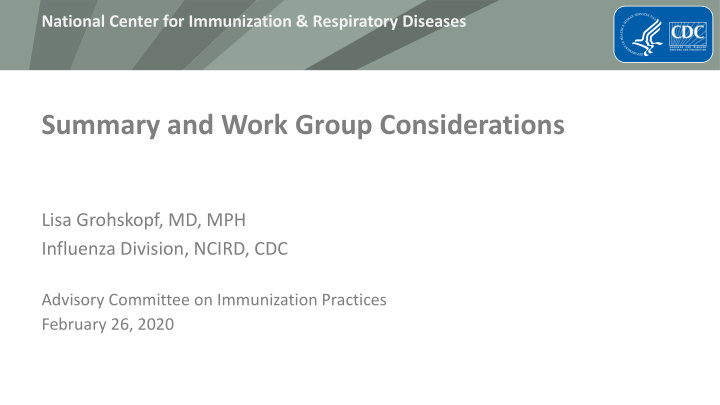



National Center for Immunization & Respiratory Diseases Summary and Work Group Considerations Lisa Grohskopf, MD, MPH Influenza Division, NCIRD, CDC Advisory Committee on Immunization Practices February 26, 2020
Acknowledgments Influenza Division Immunization Safety Office Elif Alyanak Karen Broder Lenee Blanton Frank Destefano Lynnette Brammer Penina Haber Joe Bresee Tom Shimabukuro Alicia Budd Jessie Chung Scott Epperson Immunization Services Division Jill Ferdinands Sam Graitcer Brendan Flannery Andrew Kroger Alicia Fry Amy Parker Fiebelkorn Dan Jernigan Jeanne Santoli Krista Kniss Manish Patel Rebecca Morgan Melissa Rolfes Jerry Tokars Tim Uyeki
Influenza Vaccine Distribution Update
Influenza Vaccines for Older Adults— WG Considerations
Abbreviations IIV Inactivated Influenza Vaccine ccIIV Cell culture based Inactivated Influenza Vaccine aIIV Adjuvanted Inactivated Influenza Vaccine HD-IIV High-Dose Inactivated Influenza Vaccine RIV Recombinant Influenza Vaccine LAIV Live Attenuated Influenza Vaccine Numbers indicate the number of influenza virus antigens: 3 for trivalent: an A(H1N1), an A(H3N2), and one B (from one lineage) 4 for quadrivalent: an A(H1N1), an A(H3N2), and two Bs (one from each lineage)
U.S.-Licensed Influenza Vaccines Available for 2019-20 Available vaccines by FDA-licensed age indication: Vaccine 6 through 23 2 through 3 4 through 17 18 through 49 50 through 64 ≥65 yrs type mos yrs yrs yrs yrs IIV4s (egg-based) Afluria Quadrivalent Fluarix Quadrivalent FluLaval Quadrivalent Fluzone Quadrivalent IIV4 (cell-based) Flucelvax Quadrivalent RIV4 (recombinant) Flublok Quadrivalent Adjuvant IIV3 (egg-based) Fluad High-dose IIV3 (egg-based) Fluzone High-dose LAIV4 (egg-based) FluMist Quadrivalent ACIP recommends that a licensed, age-appropriate influenza vaccine should be used. • No preferential recommendations are made for any specific influenza vaccine for any age group, where • there is more than one that is appropriate.
Systematic Review/Meta-analysis--Question Whether the relative benefits and harms of HD-IIV, aIIV, and RIV, as compared with one another and with other influenza vaccines, favor the use of any one or more of these vaccines over other age-appropriate influenza vaccines for persons ≥65 years of age.
Current Systematic Review/Meta-analysis—PICO (1) Population: Adults aged ≥65 years Interventions: Trivalent/quadrivalent high dose IIV, adjuvanted IIV, or RIV (U.S.-licensed, or similar in formulation/manufacture to U.S.-licensed) Comparators: Other trivalent or quadrivalent influenza vaccine (U.S.-licensed, or similar in formulation/manufacture to U.S.-licensed) Non-influenza control vaccine Placebo No vaccine
Current Systematic Review/Meta-analysis—PICO (2) Primary Outcomes: Efficacy/Effectiveness All influenza -- A and B – Influenza-associated outpatient/emergency visits – Influenza-associated hospitalizations – Influenza-associated deaths – Safety Any systemic adverse event (grade ≥3) – Any injection site adverse event (grade ≥3) – Any serious adverse event (SAE) – Guillain-Barre syndrome –
Current Systematic Review/Meta-analysis—PICO (3) Secondary Outcomes: To the extent data are available, the following will be summarized: Influenza-associated outpatient/emergency visits, hospitalizations, and deaths, – stratified by influenza virus type/subtype Serious adverse events (SAEs) judged to be related to study intervention –
Inclusion/Exclusion Criteria Peer-reviewed literature; no language restriction Publication dates from 1990 forward Main inclusion criteria: Randomized studies (individually- and cluster-randomized designs) – Retrospective case-control studies (traditional and test-negative designs) – Retrospective and prospective cohort studies. – Main exclusion criteria: Data involving influenza vaccines not licensed in the United States for persons ≥65 years of age – Studies/data for which the entire population falls outside age range of interest – Studies/data assessing monovalent or bivalent vaccines – Case series, case reports, registry reports without comparator or denominator information – Animal studies – Interim reports superseded by final reports –
Thank you
Recommend
More recommend